Recent Articles
Popular Makes
Body Types
2018 Hyundai Ioniq Plug-in Hybrid Road Test and Review
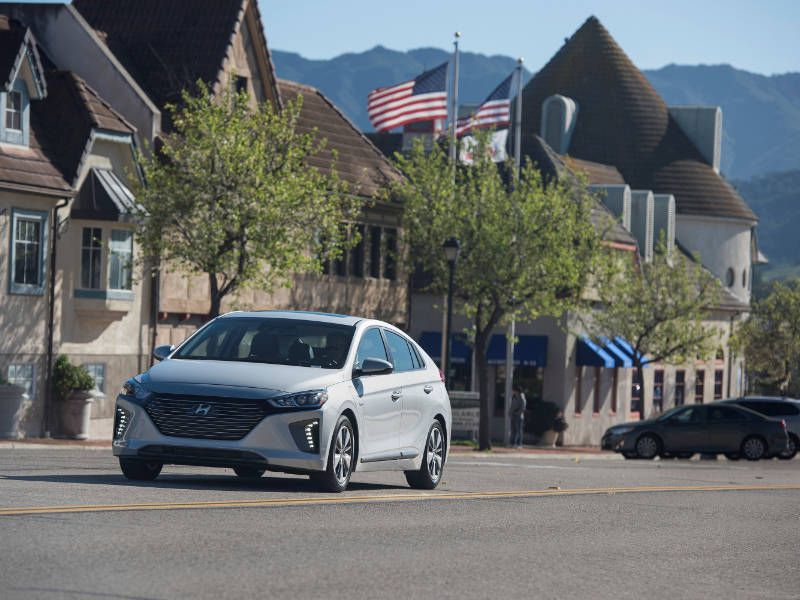
2018 Hyundai Ioniq plug in hybrid hero ・ Photo by Hyundai
The 2018 Hyundai Ioniq is the first vehicle to be offered with three electric powertrains. It is available as an all-electric car, a gas-electric hybrid, and a plug-in hybrid electric vehicle, or PHEV. While the hybrid and electric versions made their debuts when the Ioniq was announced last year, the PHEV is new for 2018 and completes the Ioniq lineup.
Each Ioniq appeals to a certain buyer, and although they look the same at first glance, these are three distinct vehicles. They also have varying availability: The hybrid is in dealerships nationwide, the electric is only for sale in California and the new PHEV is currently limited to the 10 zero-emission vehicle (ZEV) states. Let’s take a closer look at the 2018 Hyundai Ioniq PHEV and see if it’s the right choice for you.
Trims and Pricing
The Ioniq PHEV is available in two trim levels. The base model starts at $24,950 and its standard features include a six-way manual driver’s seat, dual automatic temperature control, heated front seats, a leather-wrapped steering wheel and shift knob, and a 7-inch high-resolution touchscreen with Apple CarPlay and Android Auto connectivity. It also has heated side mirrors, LED daytime running lights and automatic headlights.
The Limited trim is priced from $28,300 and adds a 10-way power driver’s seat with lumbar, leather seating surfaces and premium door sill plates. The Ultimate Package for Limited at $3,750 adds numerous convenience and safety features. This includes a power tilt-and-slide sunroof, Blue Link connected car services, wireless device charging, an eight-speaker Infinity premium audio system and a larger 8-inch touchscreen. Added safety features in this package include automatic emergency braking with pedestrian detection, lane keep assist, smart cruise control, rear parking sensors and headlights with dynamic bending.
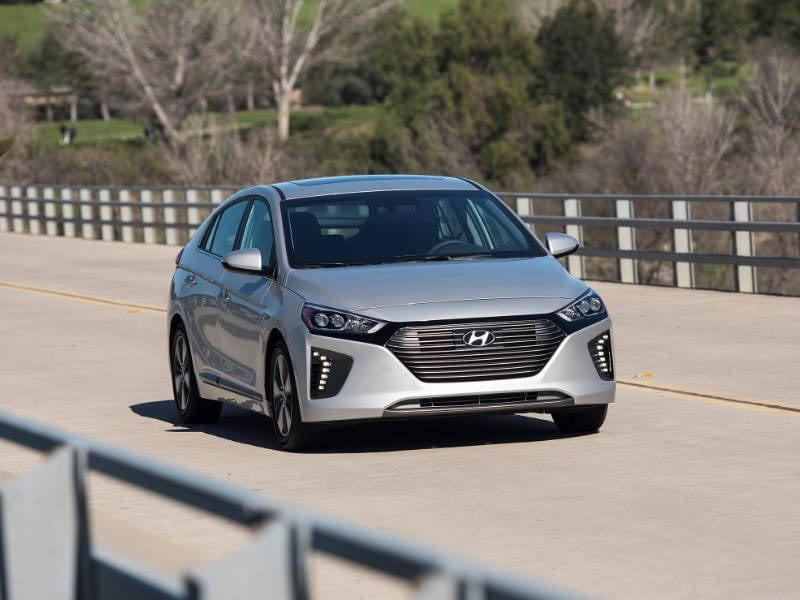
Photo by Hyundai
Powertrain
The Ioniq PHEV is powered by a 1.6-liter direct-injected four-cylinder engine with 104 horsepower and 109 lb-ft of torque. This is paired to a six-speed dual-clutch automatic transmission rather than the continuously variable transmission often favored in hybrid and plug-in hybrid vehicles. It makes a significant difference in how the car drives. Rather than the whining, straining sound of a CVT, the Ioniq PHEV has smooth, quiet shifts that give even power delivery.
This engine works along with a 45-kW electric motor with 60 horsepower and 125 lb-ft of torque. It is powered by an 8.9-kWh lithium-ion polymer battery. This gives the Ioniq PHEV 139 total system horsepower. That isn’t a lot of power. It’s not as noticeable driving around town but merging into highway traffic is a challenge. Acceleration is lackluster, particularly if you need extra speed on the highway for passing.
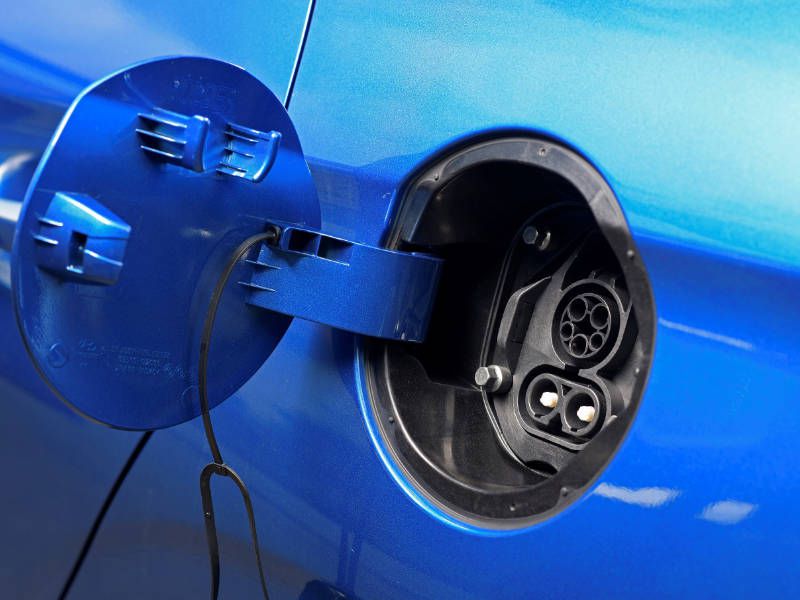
Photo by Hyundai
Range and Charge Times
The Ioniq PHEV has an all-electric range of over 29 miles and operates in electric mode at speeds up to 75 mph. After that point, the gasoline engine and electric motor work together like a normal hybrid, improving fuel economy. Its combined range is up to 630 miles reducing the need to stop as often to fuel up on longer road trips.
When you do decide to stop, it takes 2 hours and 18 minutes to reach a full charge at a 240-volt Level 2 charging station. Using a 120-volt charger, it takes 9 hours, which makes it more suited to overnight charging. DC fast charging is not available. The beauty of a plug-in hybrid is that you don’t have to stop and wait for it to charge at all. The gas engine takes over whenever the charge is too low, so range anxiety is never an issue.
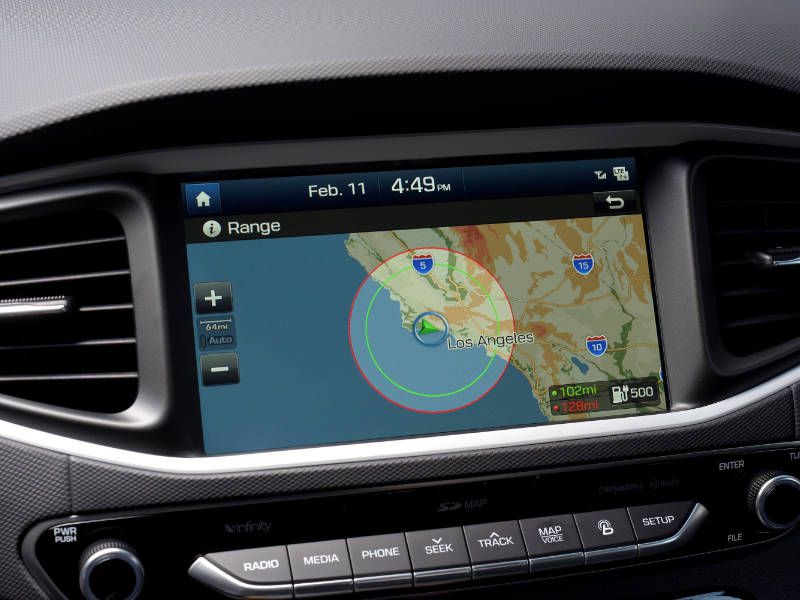
Photo by Hyundai
Fuel Economy
There are lots of reasons to go with a plug-in hybrid vehicle. Its reduced environmental impact is a key consideration, but at the top of the list is its impressive fuel economy. The Ioniq PHEV achieves an EPA-estimated all-electric 119 MPGe with 52 mpg combined fuel economy in hybrid mode. Gas prices are low today, but if they rise, then the Ioniq PHEV ensures you won’t feel quite such a hit to your wallet.
How does the Ioniq fare against competitors? Let’s take a look at the Toyota Prius Prime, which gets an EPA-estimated 133 MPGe with 54 mpg combined. The Ioniq doesn’t quite match those figures, but it’s still competitive, especially when you consider its lower starting price.
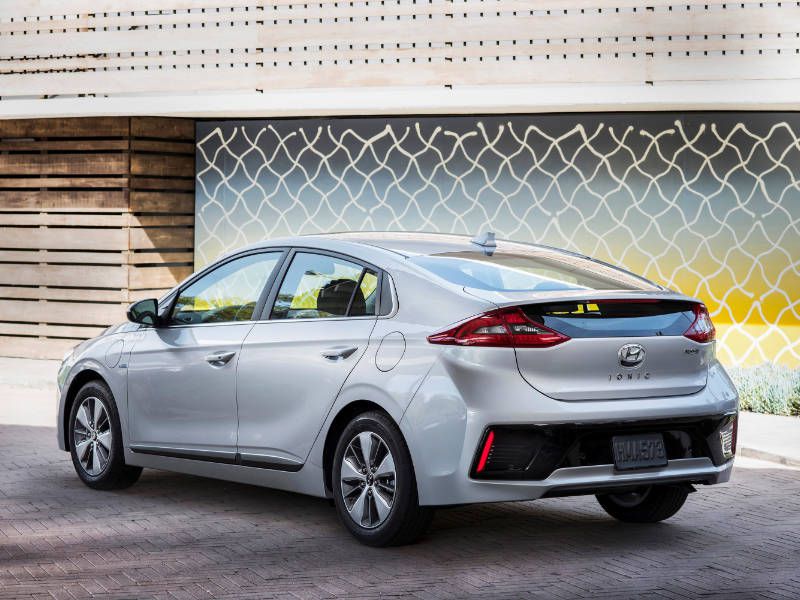
Photo by Hyundai
Ride and Handling
The ride in the Ioniq PHEV is impressively smooth. The suspension evens out rough road surfaces and even manages to handle deep potholes without jarring passengers. It’s also quiet, especially in electric-only driving, which creates an almost hushed cabin space that feels like a refuge from the outside world. The Ioniq’s aerodynamic body keeps wind noise to a minimum, too, and even heavy rain can’t break the sense of calm inside the cabin.
Handling is also good, with responsive steering that keeps the driver relaxed at the wheel. Hyundai placed the battery systems under the rear seats to create a low center of gravity and further improve handling. The Ioniq PHEV maintains its composure even on rough roads and is especially comfortable to pilot over long distances. It provides a good balance by being responsive without demanding the constant corrections common in sportier cars.
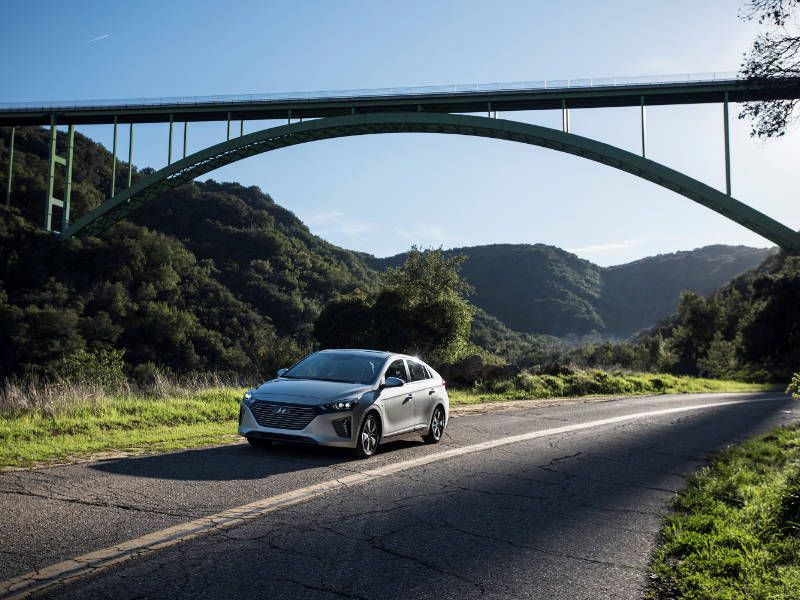
Photo by Hyundai
Interior
The interior of the Ioniq is unique for not being unique. Cars that are available only as hybrids or electrics often have weirdly futuristic interiors. They look different than the norm as if that somehow reinforces the idea that you’re driving the car of the future. The Ioniq doesn’t subscribe to that point of view and it’s refreshing. This looks like any other car in all the right ways.
There’s an attractive, uncluttered dashboard with an easy-to-use infotainment system. The focus on reducing weight to improve fuel economy does lend itself to a heavy use of plastics, but they’re not garish. On the Limited model, they’re combined with leather seats that make the interior more appealing overall. Seating is comfortable with supportive front seat and space for three adults in back, although with limited headroom due to the Ioniq’s sloping roofline. It’s not fancy, but it’s a pleasant, attractive space.
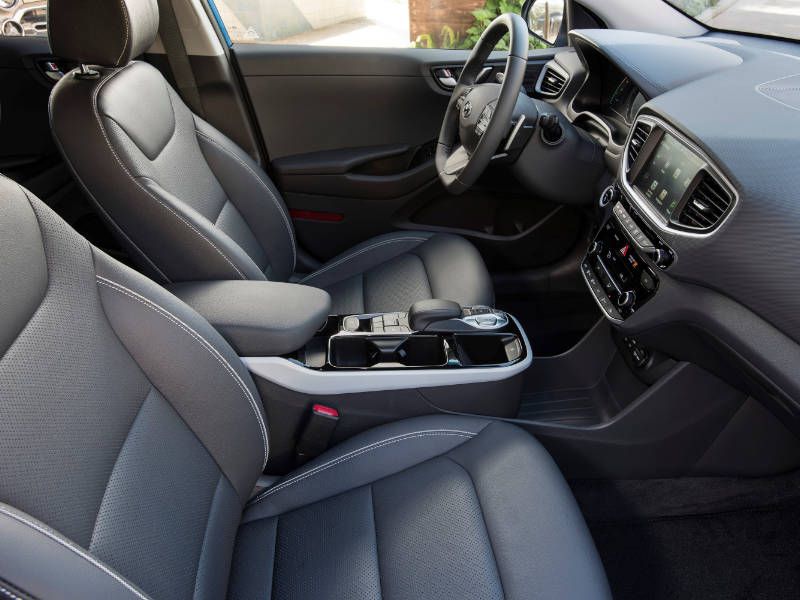
Photo by Hyundai
Cargo Capacity
One of the challenges with any hybrid or electric vehicle is where to put its large battery to make sure there’s still some decent cargo room. Often the battery eats into trunk space making it a tight fit for larger items. In the Ioniq PHEV, the battery is below the rear seats to keep it from affecting cargo space.
Since this is a hatchback, it has great flexibility for cargo or people depending on your needs. There’s 23 cubic feet of trunk space, and the rear seat folds in a 60/40 split to expand volume. The Ioniq also has a low load floor, so you don’t have to struggle to lift heavy items. When it comes to smaller cargo, there are lots of cubbies including a long, narrow spot up front that’s perfect for holding a tablet, smartphone or even a wallet.
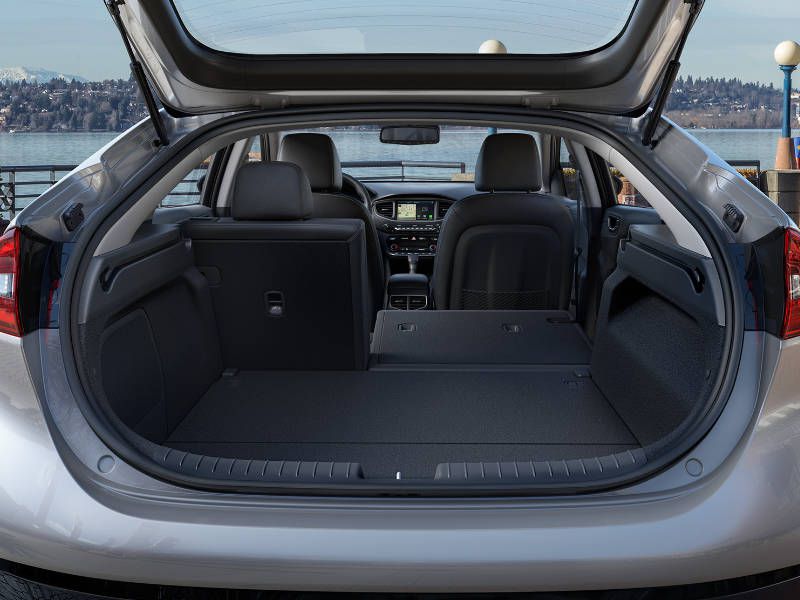
Photo by Hyundai
Safety
The 2018 Hyundai Ioniq PHEV has not been crash-tested by either the Insurance Institute for Highway Safety or the National Highway Traffic Safety Administration, though the Ioniq hybrid earned strong IIHS scores. Standard safety features include driver’s blind spot mirror, a rearview camera, electronic stability control, electronic brake-force distribution, brake assist and multiple airbags. Standard on the Limited only is a blind-spot monitor with rear cross-traffic alert and lane-change assist.
Additional advanced safety features are available only on the Limited trim with the $3,750 Ultimate Package. It includes automatic emergency braking, smart cruise control, lane-keep assist, rear parking sensors, HID headlights with an LED light guide, and dynamic bending light. It also adds Blue Link connected car features and an 8-inch screen infotainment touchscreen with navigation. It’s a well-priced package, but unfortunately one not available on the base model.
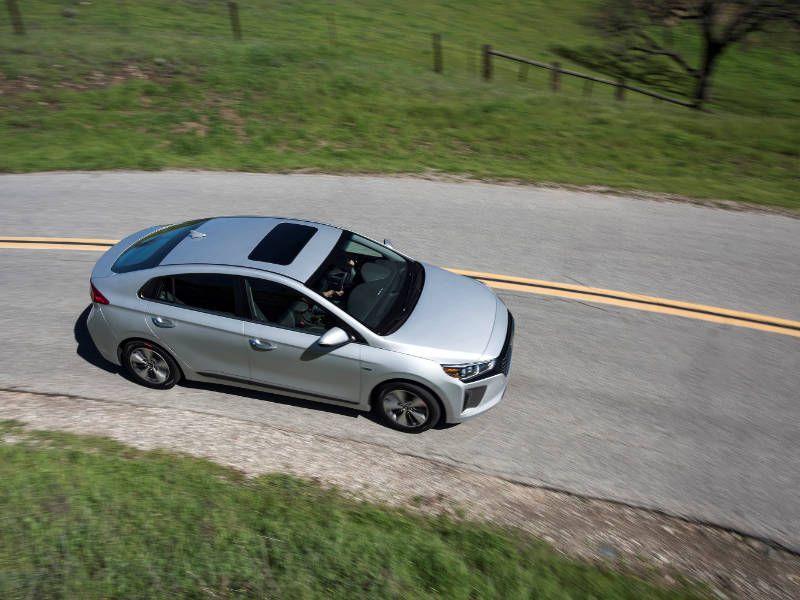
Photo by Hyundai
Final Thoughts
The 2018 Hyundai Ioniq PHEV rounds out the Ioniq lineup with a plug-in hybrid model. This offers something of a happy medium between a hybrid and a full electric car for those who aren’t quite convinced they’re ready to make that switch. It has attractive exterior styling and an interior in keeping with traditional cars rather than the out-there styling of other PHEVs and electrics.
It has good fuel economy numbers and good cargo room, but what makes the Ioniq PHEV a standout is pricing. It's an affordable choice for those on a budget, with a starting price under $25,000 before any incentives. Those who want the fuel efficiency of a plug-in hybrid with a sticker price that lets them stay on budget will find the 2018 Hyundai Ioniq PHEV an attractive option.

Photo by Hyundai